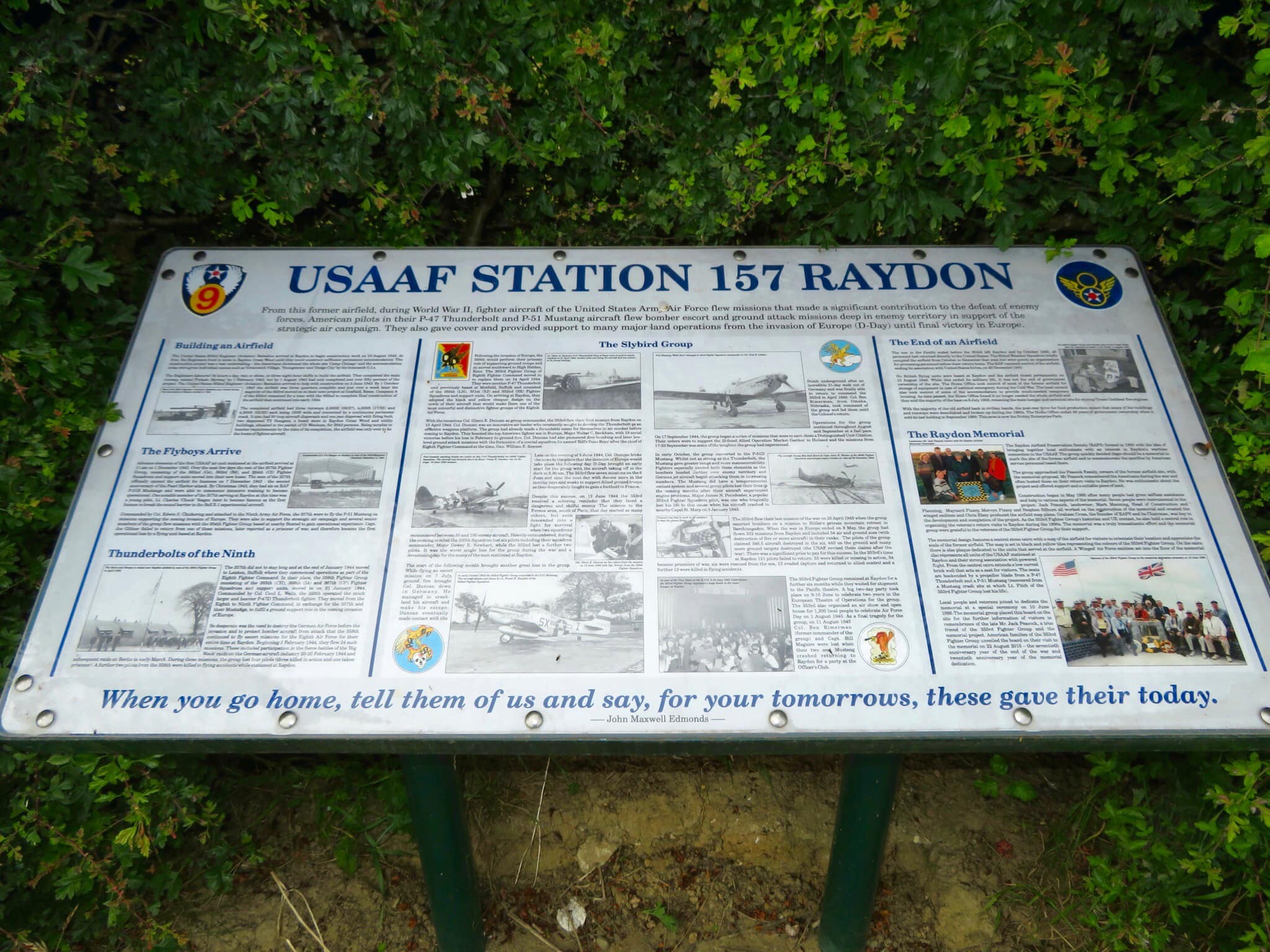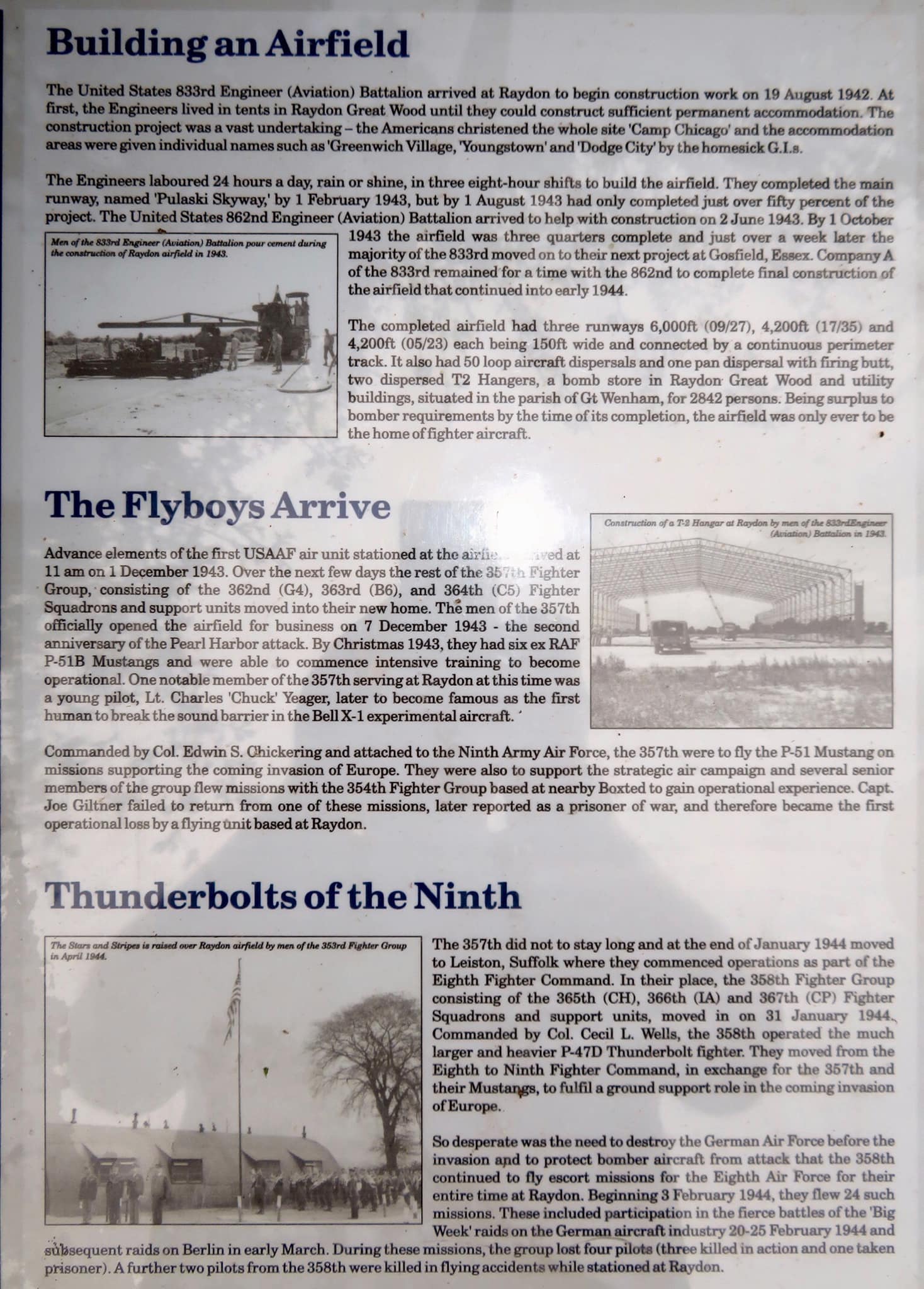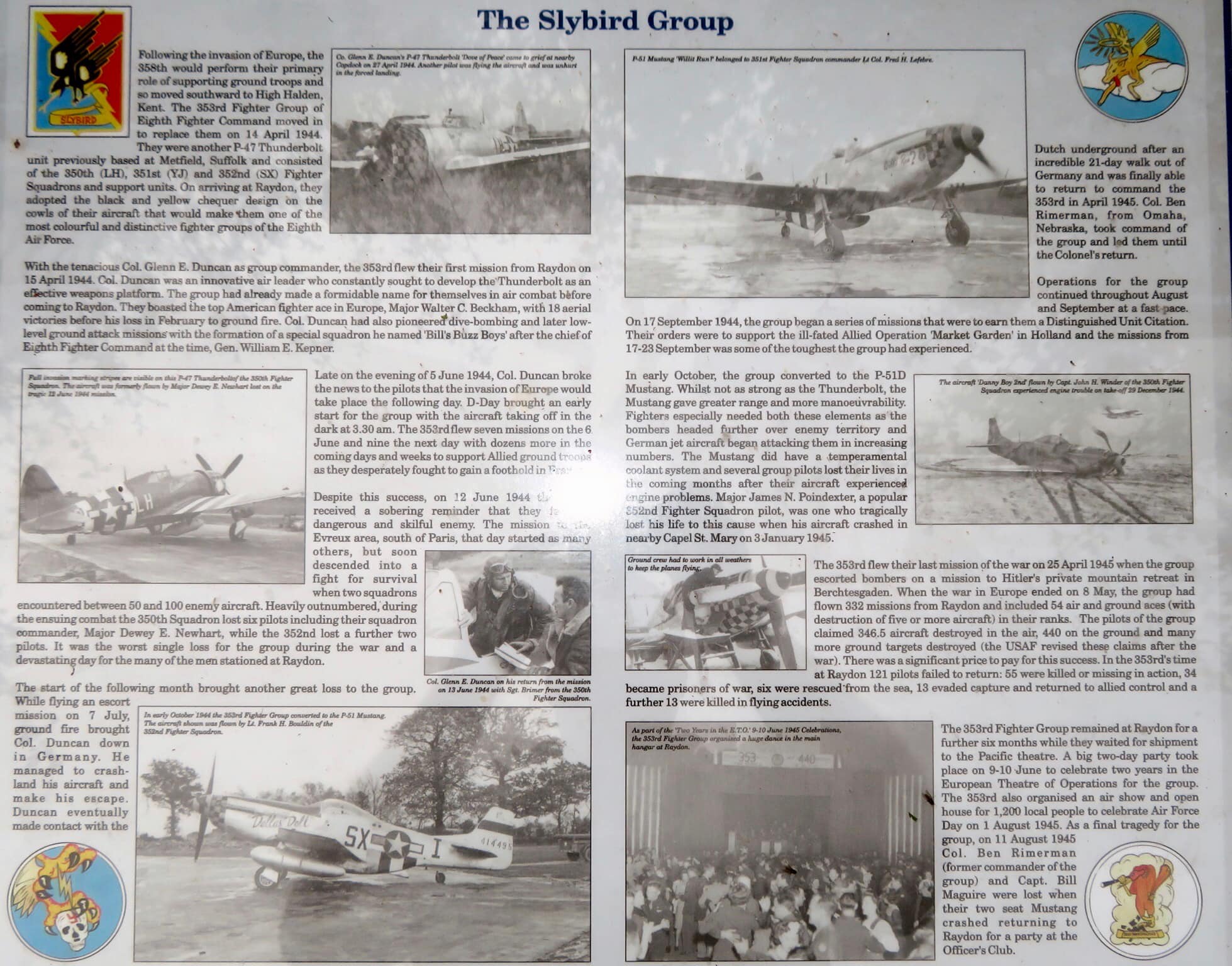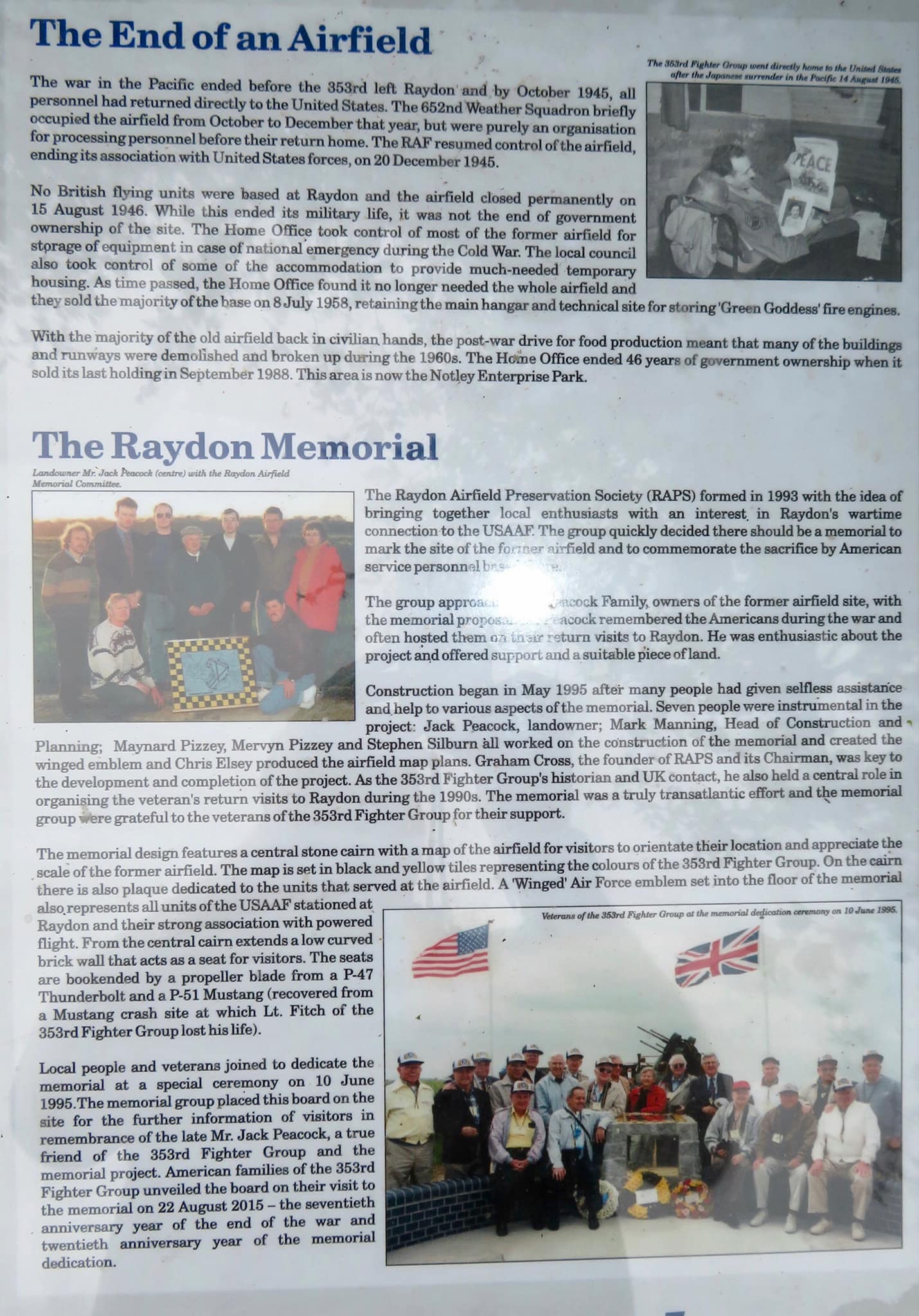Raydon Airfield (USAAF Station 157) Memorial Info Sign
Details:
On the right-hand side in front of the memorial.
A large, rectangular, white board with a plexiglass panel, printed in English text and various colored images. The info sign details the history of the USAAF Station 157 Raydon from the construction of the airfield until the end of operation of the former airfield as well as the erection of the Raydon memorial.
Source of images: Aviation History Around Anglia Facebook Page
Monument Text:
USAAF STATION 157 RAYDON
From this former airfield, during World War II, fighter aircraft of the US Army Air Force flew missions that made a significant contribution to the defeat of enemy forces. American pilots in their P-47 Thunderbolt and P-51 Mustang aircraft flew bomber escort and ground attack missions deep in enemy territory in support of the strategic air campaign. They also gave cover and provided support to many major land operations from the invasion of Europe (D-Day) until final victory in Europe.
1st Column:
Building an Airfield
The United States 833rd Engineer (Aviation) Battalion arrived at Raydon to begin construction work on 19 August 1942. At first, the Engineers lived in tenth in Raydon Great Wood until they could construct sufficient permanent accommodation. The construction project was a vast undertaking - the Americans christened the whole site 'Camp Chicago' and the accommodation areas were given individual names such as 'Greenwich Village, 'Youngstown' and 'Dodge City' by the homesick G.I.s.
The Engineers laboured 24 hours a day, rain or shine, in three eight-hour shifts to build the airfield. They completed the main runway, named 'Pulaski Skyway,' by 1 February 1943, but by 1 August 1943 had only completed just over fifty percent of the project. The United States 862nd Engineer (Aviation) Battalion arrived to help with construction on 2 June 1943. By 1 October 1943 the airfield was three quarters complete and just over a week later the majority of the 833rd moved on to their next project at Gosfield, Essex. Company A of the 833rd remained for a time with the 862nd to complete final construction of the airfield that continued into early 1944.
(- image on the left side-)
Men of the 833rd Engineer (Aviation) Battalion pour cement during
the construction of Raydon airfield in 1943.
The completed airfield had three runways 6,000ft (09/27), 4,200ft (17/35) and 4,200ft (05/23) each being 150ft wide and connected by a continuous perimeter track. It also had 50 loop aircraft dispersals and one pan dispersal with firing butt, two dispersed T2 Hangers, a bomb store in Raydon Great Wood and utility buildings, situated in the parish of Gt Wenham, for 2842 persons Being surplus to bomber requirements by the time of its completion, the airfield was only ever to be the home of fighter aircraft.
The Flyboys Arrive
Advance elements of the first USAAF air unit stationed at the airfield arrived at 11 am on 1 December 1943. Over the next few days the rest of the 357th Fighter Group, consisting of the 362nd (G4), 363rd (B6), and 364th (C5) Fighter Squadrons and support units moved into their new home. The men of the 357th officially opened the airfield for business on 7 December 1943 - the second anniversary of the Pearl Harbor attack. By Christmas 1943, they had six ex RAF P-51B Mustangs and were able to commence intensive training to become operational. One notable member of the 357th serving at Raydon at this time was a young pilot, Lt. Charles 'Chuck' Yeager, later to become famous as the first human to break the sound barrier in the Bell X-1 experimental aircraft.
(- image on the right side-)
Construction of a T-2 Hangar at Raydon by men of the 833rd Engineer
(Aviation) Battalion in 1943.
Commanded by Col. Edwin S. Chickering and attached to the Ninth Army Air Force, the 357th were to fly the P-51 Mustang on missions supporting the coming invasion of Europe. They were also to support the strategic air campaign and several senior members of the group flew missions with the 354th Fighter Group based at nearby Boxted to gain operational experience. Capt. Joe Giltner failed to return from one of these missions, later reported as a prisoner of war, and therefore became the first operational loss by a flying unit based at Raydon.
Thunderbolts of the Ninth
(- image on the left side-)
The Stars and Stripes is raised over Raydon airfield by men of the 353rd Fighter Group
in April 1944.
The 357th did not to stay long and at the end of January 1944 moved to Leiston, Suffolk where they commenced operations as part of the Eighth Fighter Command. In their place, the 358th Fighter Group consisting of the 365th (CH), 366th (IA) and 367th (CP) Fighter Squadrons and support units, moved in on 31 January 1944, Commanded by Col. Cecil L. Wells, the 358th operated the much larger and heavier P-47D Thunderbolt fighter. They moved from the Eighth to Ninth Fighter Command, in exchange for the 357th and their Mustangs, to fulfill a ground support role in the coming invasion of Europe.
So desperate was the need to destroy the German Air Force before the invasion and to protect bomber aircraft from attack that the 358th continued to fly escort missions for the Eighth Air Force for their entire time at Raydon. Beginning 3 February 1944, they flew 24 such missions. These included participation in the fierce battles of the 'Big Week' raids on the German aircraft industry 20-25 February 1944 and subsequent raids on Berlin in early March. During these missions, the group lost four pilots (three killed in action and one taken prisoner). A further two pilots from the 358th were killed in flying accidents while stationed at Raydon.
2nd Column:
The Slybird Group
Following the invasion of Europe, the 358th would perform their primary role of supporting ground troops and so moved southward to High Halden, Kent. The 353rd Fighter Group of Eighth Fighter Command moved in to replace them on 14 April 1944. They were another P-47 Thunderbolt unit previously based at Metfield, Suffolk and consisted of the 350th (LH), 351st (YJ) and 352nd (SX) Fighter Squadrons and support units. On arriving at Raydon, they adopted the black and yellow chequer design on the cowls of their aircraft that would make them one of the most colourful and distinctive fighter groups of the Eighth Air Force.
(- image on the right side-)
Co Glenn E. Duncan's P-47 Thunderbolt "Dove of Peace" came to grief at nearby
Copdock on 27 April 1944. Another pilot was flying the aircraft and was unhurt
in the forced landing.
With the tenacious Col. Glenn E. Duncan as group commander, the 353rd flew their first mission from Raydon on 15 April 1944. Col. Duncan was an innovative air leader who constantly sought to develop the Thunderbolt as an effective weapons platform. The group had already made a formidable name for themselves in air combat before coming to Raydon. They boasted the top American fighter ace in Europe, Major Walter C. Beckham, with 18 aerial victories before his loss in February to ground fire. Col. Duncan had also pioneered dive-bombing and later low-level ground attack missions with the formation of a special squadron he named 'Bill's Buzz Boys' after the chief of Eighth Fighter Command at the time, Gen. William E. Kepner.
(- image on the left side-)
Full invasion marking stripes are visible on this P-47 Thunderbolt of the 350th Fighter
Squadron. The aircraft was flown by Major Dewey E. Newhart lost on the
tragic 12 June 1944 mission.
Late on the evening of 5 June 1944, Col. Duncan broke the news to the pilots that the invasion of Europe would take place the following day. D-Day brought an early start for the group with the aircraft taking off in the dark at 3.30 am. The 353rd flew seven missions on the 6 June and nine the next day with dozens more in the coming days and weeks to support Allied ground troops as they desperately fought to gain a foothold in France.
Despite this success, on 12 June 1944 [illegible] received a sobering reminder that they fought a dangerous and skillful enemy. The mission to the Evreux area, south of Paris, that day started as many others, but soon descended into a fight for survival when two squadrons encountered between 50 and 100 enemy aircraft. Heavily outnumbered, during the ensuing combat the 350th Squadron lost six pilots including their squadron commander, Major Dewey E. Newhart, while the 352nd lost a further two pilots. It was the worst single loss for the group during the war and a devastating day for the many of the men stationed at Raydon.
(- image on the right side-)
Col. Glenn E. Duncan on his return from the mission
on 13 June 1944 with Sgt. Brimer from the 350th
Fighter Squadron
The start of the following month brought another great loss to the group. While flying an escort mission on 7 July, ground fire brought Col. Duncan down in Germany. He managed to crash-land his aircraft and make his escape. Duncan eventually made contact with the
(- image on the right side-)
In early October 1944 the 353rd Fighter Group converted to the P-51 Mustang.
The aircraft shown was flown by Lt. Frank H. Bouldin of the
352nd Fighter Squadron.
(- image on the left side-)
P-51 Mustang 'Willit Run!' belonged to the 351st Fighter Squadron commander Lt. Col. Fred H. Lefebre.
Dutch underground after an incredible 21-day walk out of Germany and was finally able to return to command the 353rd in April 1945. Col. Ben Rimerman, from Omaha, Nebraska, took command of the group and led them until the Colonel's return.
Operations for the group continued throughout August and September at a fast-pace. On 17 September 1944, the group began a series of missions that were to earn them a Distinguished Unit Citation. Their orders were to support the ill-fated Allied Operation 'Market Garden' in Holland and the missions from 17-23 September was some of the toughest the group bad experienced.
In early October, the group converted to the P-51D Mustang. Whilst not as strong as the Thunderbolt, the Mustang gave greater range and more manoeuvrability. Fighters especially needed both these elements as the bombers headed further over enemy territory and German jet aircraft began attacking them in increasing numbers. The Mustang did have a temperamental coolant system and several group pilots lost their lives in the coming months after their aircraft experienced engine problems. Major James N. Poindexter, a popular 352nd Fighter Squadron pilot, was one who tragically lost his life to this cause when his aircraft crashed in nearby Capel St. Mary on 3 January 1945.
(- image on the right side-)
The aircraft 'Danny Boy 2nd' flown by Capt. John H. Winder of the 350th Fighter
Squadron experienced engine trouble on take-off 29 December 1944.
(- image on the left side-)
Ground crew had to work in all weathers
to keep the planes flying.
The 353rd flew their last mission of the war on 25 April 1945 when the group escorted bombers on a mission to Hitler's private mountain retreat in Berchtesgaden. When the war in Europe ended on 8 May, the group had flown 332 missions from Raydon and included 54 air and ground aces (with destruction of five or more aircraft) in their ranks. The pilots of the group claimed 346.5 aircraft destroyed in the air, 440 on the ground and many more ground targets destroyed (the USAF revised these claims after the war). There was a significant price to pay for this success. In the 353rd's time at Raydon 121 pilots failed to return: 55 were killed or missing in action, 34 became prisoners of war, six were rescued from the sea, 13 evaded capture and returned to allied control and a further 13 were killed in flying accidents.
(- image on the left side-)
As part of the 'Two Years in the E.T.O.' 9-10 June 1945 Celebrations,
the 353rd Fighter Group organized a huge dance in the main
hangar at Raydon.
The 353rd Fighter Group remained at Raydon for a further six months while they waited for shipment to the Pacific theatre. A big two-day party took place on 9-10 June to celebrate two years in the European Theatre of Operations for the group. The 353rd also organised an air show and open house for 1,200 local people to celebrate Air Force Day on 1 August 1945. As a final tragedy for the group, on 11 August 1945 Col. Ben Rimerman (former commander of the group) and Capt. Bill Maguire were lost when their two seat Mustang crashed returning to Raydon for a party at the Officer's Club.
3rd Column:
The End of an Airfield
The war in the Pacific ended before the 353rd left Raydon and by October 1945, all personnel had returned directly to the United States. The 652nd Weather Squadron briefly occupied the airfield from October to December that year, but were purely an organisation for processing personnel before their return home. The RAF resumed control of the airfield, ending its association with United States forces, on 20 December 1945.
The 353rd Fighter Group went directly home to the United States
after the Japanese surrender in the Pacific 14 August 1945.
(- image on the right side-)
No British flying units were based at Raydon and the airfield closed permanently on 15 August 1946. While this ended its military life, it was not the end of government ownership of the site. The Home Office took control of most of the former airfield for storage of equipment in case of national emergency during the Cold War. The local council also took control of some of the accommodation to provide much-needed temporary housing. As time passed, the Home Office found it no longer needed the whole airfield and they sold the majority of the base on 8 July 1958, retaining the main hangar and technical site for storing 'Green Goddess' fire engines.
With the majority of the old airfield back in civilian hands, the post-war drive for food production meant that many of the buildings and runways were demolished and broken up during the 1960s. The Home Office ended 46 years of government ownership when it sold its last holding in September 1988. This area is now the Notley Enterprise Park.
The Raydon Memorial
Landowner Mr. Jack Peacock (centre) with the Raydon Airfield
Memorial Committee.
(- image on the left side-)
The Raydon Airfield Preservation Society (RAPS) formed in 1993 with the idea of bringing together local enthusiasts with an interest, in Raydon's wartime connection to the USAAF. The group quickly decided there should be a memorial to mark the site of the former airfield and to commemorate the sacrifice by American service personnel based there.
The group approached the Peacock Family, owners of the former airfield site, with the memorial proposal. Peacock remembered the Americans during the war and often hosted them on their return visits to Raydon. He was enthusiastic about the project and offered support and a suitable piece of land.
Construction began in May 1995 after many people had given selfless assistance and help to various aspects of the memorial. Seven people were instrumental in the project: Jack Peacock, landowner; Mark Manning, Head of Construction and Planning; Maynard Pizzey, Mervyn Pizzey and Stephen Silburn all worked on the construction of the memorial and created the winged emblem and Chris Elsey produced the airfield map plans. Graham Cross, the founder of RAPS and its Chairman, was key to the development and completion of the project. As the 353rd Fighter Group's historian and UK contact, he also held a central role in organising the veteran's return visits to Raydon during the 1990s. The memorial was a truly transatlantic effort and the memorial group were grateful to the veterans of the 353rd Fighter Group for their support.
The memorial design features a central stone cairn with a map of the airfield for visitors to orientate their location and appreciate the scale of the former airfield. The map is set in black and yellow tiles representing the colours of the 353rd Fighter Group. On the cairn there is also plaque dedicated to the units that served at the airfield. A 'Winged' Air Force emblem set into the floor of the memorial also represents all units of the USAAF stationed at Raydon and their strong association with powered flight. From the central cairn extends a low curved brick wall that acts as a seat for visitors. The seats are bookended by a propeller blade from a P-47 Thunderbolt and a P-51 Mustang (recovered from a Mustang crash site at which Lt. Fitch of the 353rd Fighter Group lost his life).
Veterans of the 353rd Fighter Group at the memorial dedication ceremony on June 10, 1995.
(- image on the right side-)
When you go home, tell them of us and say, for your tomorrows, these gave their today.
---John Maxwell Edmonds---
Commemorates:
People:
Joseph "Joe" Harvey, Jr. Giltner
Units:
350th Fighter Squadron, 353rd Fighter Group
351st Fighter Squadron, 353rd Fighter Group
352nd Fighter Squadron, 353rd Fighter Group
353rd Fighter Group
354th Fighter Group
357th Fighter Group
358th Fighter Group
362nd Fighter Squadron, 357th Fighter Group
363rd Fighter Squadron, 357th Fighter Group
364th Fighter Squadron, 357th Fighter Group
365th Figther Squadron, 358th Fighter Group
366th Fighter Squadron, 358th Fighter Group
367th Fighter Squadron, 358th Fighter Group
652nd Weather Squadron
833rd Air Engineer Battalion
862nd Aviation Engineer Battalion
8th Air Force
9th Air Force
Wars:
WWII
Other images :




